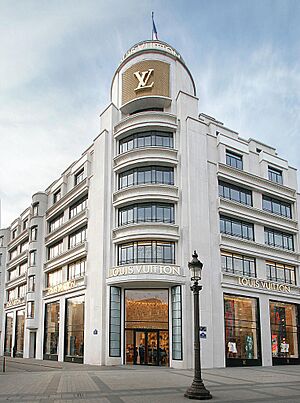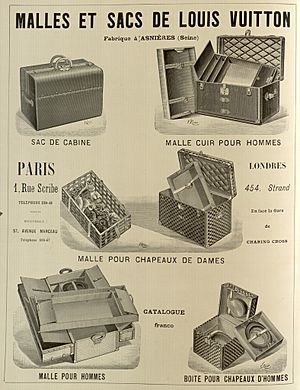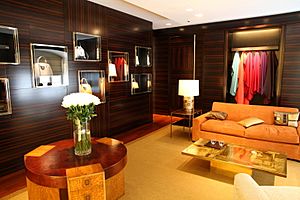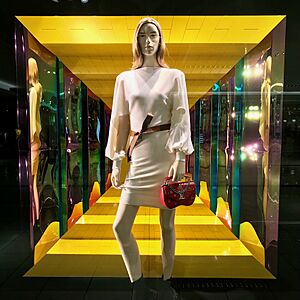Louis Vuitton facts for kids

Champs-Élysées flagship store, Paris
|
|
| Subsidiary (SAS) | |
| Industry | Fashion |
| Founded | 1854 Paris, France |
| Founder | Louis Vuitton |
| Headquarters | |
|
Key people
|
|
| Products |
|
| Revenue | |
|
Number of employees
|
19,000 (2013) |
| Parent | LVMH |
Louis Vuitton Malletier, often called Louis Vuitton, is a famous French luxury fashion house. It was started in 1854 by Louis Vuitton. The company's special "LV" monogram is on most of its items. These include fancy bags, ready-to-wear clothes, shoes, perfumes, and watches.
Louis Vuitton is one of the world's top fashion brands. You can buy its products in special stores, fancy department stores, and online. For six years in a row (2006–2012), Louis Vuitton was named the world's most valuable luxury brand. In 2013, the brand was worth about US$28.4 billion. Today, the company has over 460 stores in 50 countries. It is part of a bigger company called LVMH.
Contents
History of Louis Vuitton
Starting the Company (1854-1945)
The Louis Vuitton brand began in 1854 in Paris. Louis Vuitton noticed that some travel trunks could be easily stacked. In 1858, he made his own flat-topped trunks. These trunks were light and sealed tightly. Before this, trunks had rounded tops to let water run off. This meant they could not be stacked easily. Vuitton's flat trunks made travel much simpler. Many other luggage makers soon copied his ideas.
The company showed its products at the 1867 Universal Exhibition in Paris. To stop others from copying his designs, Vuitton changed his trunk pattern in 1876. It became a beige-and-brown stripe design. By 1885, the first Louis Vuitton store opened in London. Because people kept copying his designs, Vuitton created the Damier Canvas pattern in 1888. This pattern had a logo that said "L. Vuitton registered trademark". In 1892, Louis Vuitton passed away. His son, Georges Vuitton, took over the company.
Georges Vuitton wanted to make the company known worldwide. He showed products at the Chicago World's Fair in 1893. In 1896, the company launched its famous Monogram canvas. This design had special symbols like flowers and the LV monogram. These patterns helped stop people from making fake products. In 1901, Louis Vuitton introduced the Steamer Bag. This was a smaller bag meant to be kept inside larger trunks.
By 1913, the Louis Vuitton Building opened in Paris. It was the biggest travel-goods store in the world at that time. Stores also opened in New York, London, and other major cities. In 1930, the Keepall bag was introduced. In 1932, the Noé bag was created. This bag was first made for carrying champagne bottles. Soon after, the Louis Vuitton Speedy bag was also launched. Both the Noé and Speedy bags are still made today. In 1936, Georges Vuitton died, and his son, Gaston-Louis Vuitton, became the head of the company.
Louis Vuitton During World War II
During World War II, Louis Vuitton continued its business in France. A book called Louis Vuitton, A French Saga says that members of the Vuitton family worked with the government at the time. They made items that praised the leader, including many statues. A spokesperson for LVMH, the company that owns Louis Vuitton now, said this was "ancient history." They added that it happened when the company was still run by the family, long before it became part of LVMH.
Growth and New Products (1945-2000)
After World War II, Louis Vuitton started using more leather in its products. These ranged from small purses to large luggage. In 1959, the company made its Monogram canvas softer. This allowed it to be used for purses and wallets. In 1966, the Papillon bag was launched. This round bag is still popular today. By 1977, the company's yearly sales reached 70 million French Francs. A year later, the first stores in Japan opened.
In 1983, Louis Vuitton teamed up with the America's Cup sailing race. They created the Louis Vuitton Cup, a competition before the main yacht race. Louis Vuitton also opened stores in Taiwan and South Korea. In 1985, the Epi leather line was introduced.
In 1987, LVMH was formed. This happened when Louis Vuitton joined with Moët et Chandon and Hennessy, which make champagne and cognac. By 1989, Louis Vuitton had 130 stores around the world. In the 1990s, Yves Carcelle became the president of LV. In 1992, Louis Vuitton opened its first store in mainland China. New products like the Taiga leather line were also introduced. In 1996, the company celebrated 100 years of the Monogram canvas.
In 1997, Marc Jacobs became the Artistic Director for Louis Vuitton. In 1998, he designed the company's first line of ready-to-wear clothing for men and women. Other new products included the Monogram Vernis line and the Louis Vuitton City Guide. The 20th century ended with the release of the mini monogram line in 1999. In 2000, the first store in Africa opened in Morocco.
Modern Era (2001-Present)
In 2001, Stephen Sprouse and Marc Jacobs worked together. They created a special line of Vuitton bags with graffiti written over the monogram pattern. Some bags had the words Louis Vuitton or the bag's name, like Keepall. Jacobs also designed the first piece of jewelry for LV, a charm bracelet.
In 2002, the Tambour watch collection was launched. The LV building in Tokyo's Ginza district also opened. In 2003, Takashi Murakami and Marc Jacobs created the Monogram Multicolore canvas. This new range of bags had the classic monograms in 33 different colors. Murakami also made the Cherry Blossom pattern, with smiling cartoon faces on pink and yellow flowers. This special edition was stopped in June 2003. Also in 2003, stores opened in Moscow and New Delhi.
In 2004, Louis Vuitton celebrated its 150th anniversary. New stores opened in New York City, São Paulo, and Shanghai. In 2005, the Champs-Élysées store in Paris reopened after being redesigned. In 2008, Louis Vuitton released the Damier Graphite canvas. This design had the classic Damier pattern in black and grey, giving it a more masculine and urban look. Also in 2008, Pharrell Williams helped design jewelry and glasses for Louis Vuitton.
In 2010, Louis Vuitton opened a very luxurious store in London. In 2011, Kim Jones became the lead designer for men's clothing. On September 17, 2011, the company opened its Louis Vuitton Island Maison in Singapore.
In 2013, Nicolas Ghesquière was hired to replace Marc Jacobs as the artistic director for women's collections. His first collection was shown in Paris in March 2014. In 2018, Virgil Abloh became the artistic director for men's wear. He was the first African-American artistic director for the brand. Abloh passed away in 2021.
In 2019, Louis Vuitton was the most valuable luxury brand in the BrandZ's top 10 list. It was worth $47.2 billion. In 2020, the company bought the Sewelô diamond, one of the largest rough diamonds ever found. In March 2022, LVMH closed its stores in Russia due to the Russo-Ukrainian War. On February 14, 2023, Pharrell Williams was named the new creative director for men's wear.
Brand and Protecting its Designs
The Louis Vuitton brand and its LV monogram are among the most valuable brands in the world. In 2011, Louis Vuitton was the number one luxury brand, worth $24.3 billion. This was more than double the value of the second-place brand.
Louis Vuitton is one of the most copied brands in fashion. This is because it is seen as a symbol of status. It's interesting that the famous Monogram canvas was first made to stop people from making fakes. In 2004, fake Louis Vuitton items made up 18% of all fake accessories found in the European Union.
The company works hard to stop counterfeiting. It has a team of lawyers and special investigators to find people who make fakes. Louis Vuitton spends about half of its advertising budget on fighting fakes. The company also controls where its products are sold very carefully. Today, you can mostly buy Louis Vuitton products in company-owned stores. They also have an official online store.
Protecting Designs in Court
Louis Vuitton has taken legal action to protect its designs.
- In 2007, Louis Vuitton sued Britney Spears because her music video for "Do Somethin'" showed what looked like a Louis Vuitton design. A court in Paris ordered Sony BMG and MTV Online to stop showing the video. They were also fined.
- In 2013, Louis Vuitton made a complaint against a barber shop in Hong Kong. The shop had a stool with fabric that looked like Louis Vuitton's checker pattern. The company asked for money and a public apology. This caused a lot of discussion online.
- In 2021, Louis Vuitton lost a case in Japan. A Japanese company was using old Japanese designs that had inspired Louis Vuitton's own patterns. People on social media in Japan pointed out that some Louis Vuitton designs look very similar to traditional Japanese patterns used for centuries.
Louis Vuitton Products
Since the 1800s, Louis Vuitton trunks have been made by hand. Skilled workers carefully line the leather and canvas. They tap in tiny nails one by one. They also secure special brass locks with a unique handmade key for each customer. This key lets a traveler open all their Louis Vuitton luggage with just one key. The wooden frames of the trunks are made from poplar wood that is at least 30 years old. Each trunk has a serial number. It can take up to 60 hours to make a trunk, and a suitcase can take 15 hours.
Some of Louis Vuitton's most famous bags include the Speedy bag, made in 1930, and the Neverfull bags, made in 2007. Both bags are popular because they are both stylish and useful. These bags come in different sizes. Each season, Louis Vuitton also makes rare, limited edition bags. These are usually only available by special order at larger stores.
Many Louis Vuitton products use the brown Damier and Monogram canvas materials. These were first used in the late 1800s. All products show the famous LV initials. The company sells its products through its own stores around the world. This helps them control the quality and prices. It also helps prevent fake products from being sold. You can also buy products on the company's official website.
In June 2021, Louis Vuitton faced some discussion about a $700 scarf called 'Monogram Keffieh'. The traditional Palestinian black and white keffiyeh has been a symbol of Palestinian identity. Louis Vuitton changed the colors to blue and white. Some people on social media said these were the colors of the flag of Israel. They felt this was disrespectful. In 2017, Louis Vuitton also caused headlines for using prints similar to Basotho blanket designs from South Africa and Lesotho. This led to accusations of cultural appropriation.
Advertising and Collaborations
Advertising Campaigns
The Louis Vuitton company is known for working with famous people. They have featured well-known models, musicians, and actors in their ads. These include Jennifer Lopez, Madonna, Angelina Jolie, and David Bowie.
The company often uses print ads in magazines and billboards in big cities. Louis Vuitton posters by Razzia were very popular in the 1980s. The company used to rely on special press for its ads. These often featured famous stars like Steffi Graf and Catherine Deneuve. Recently, Louis Vuitton has also started advertising on TV and in movies. Their first TV ad explored the theme "Where will life take you?"
In 2002, Daniel Lalonde, a CEO for LVMH Watches, brought in celebrities like Maria Sharapova and Brad Pitt for ad campaigns. These ads helped boost sales. In 2021, French actress Lea Seydoux, a Louis Vuitton ambassador, wore a custom dress to the James Bond movie premiere. The dress took over 520 hours to make and had thousands of sequins and beads. In the same year, the brand released a mobile game called Louis the Game. This was to celebrate the founder's 200th birthday and connect with younger audiences. In 2022, Deepika Padukone became a House Ambassador.
Special Collaborations
Louis Vuitton has worked with many famous artists and designers.
- Takashi Murakami created special collections. These included the Monogramouflage Collection in 2008. A previous collection in 2002 featured his artwork "painted" over the traditional monogram canvas. This gave a new look to the classic design.
- Marc Jacobs also brought back a past collaboration designed by Stephen Sprouse. This collection, first released in 2001, had bold print that looked like graffiti over the canvas. The new version used bright colors like hot pink and neon green.
- Louis Vuitton also worked with Kanye West in 2009. He designed his own limited edition shoes.
- In July 2012, Jacobs teamed up with Yayoi Kusama. They created the "Infinitely Kusama" Collection. This collection featured bold dots on leather or the Monogram canvas.
- Louis Vuitton worked with the popular Japanese video game franchise Final Fantasy for its Spring–Summer 2016 advertising campaign. The game's main character, Lightning, was featured.
- In 2017, Louis Vuitton collaborated with the American streetwear brand Supreme. They released products that mixed the Louis Vuitton Monogram canvas with the Supreme box-logo design.

- Also in 2017, Louis Vuitton worked with artist Jeff Koons. They created two collections to explore the connection between fashion and art.
- Nicolas Ghesquière worked with Vogue creative director Grace Coddington in 2018. They created a cat-themed "Catogram" collection.
- In June 2019, the brand worked with six modern artists. Each artist designed their own version of the Capucine bag. These were sold in limited numbers.
- In October 2019, Louis Vuitton partnered with Riot Games. They created digital items for a new skin line in the game League of Legends. They also made a special trophy case for the 2019 League of Legends World Championship.
- In June 2020, the brand collaborated with Japanese designer Nigo and Virgil Abloh.
- In March 2024, Tyler Okonma (also known as Tyler, The Creator) worked with Louis Vuitton to create their 2024 Spring collection.
Images for kids
See also
 In Spanish: Louis Vuitton para niños
In Spanish: Louis Vuitton para niños








